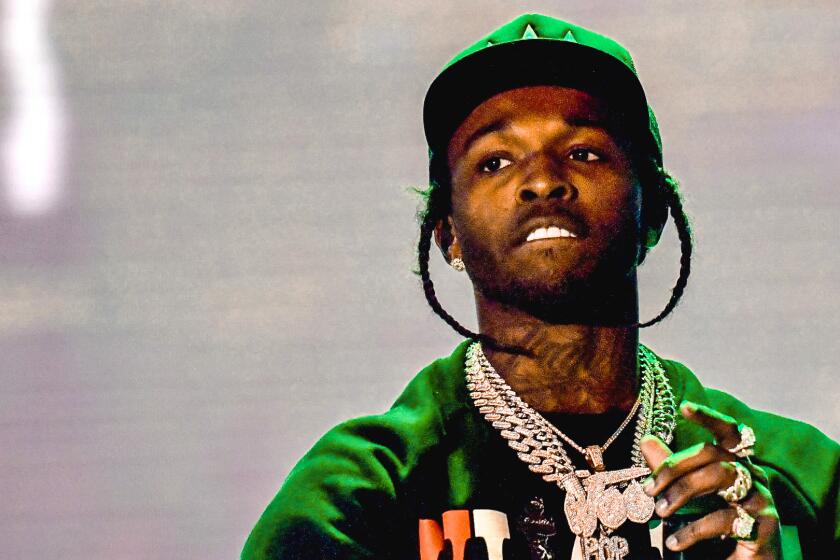A ‘PEPPERED’ EXPERIENCE
- Share via
Geoff Emerick leaned his head back and squinted, remembering.
“It was a great time,” he said. “I feel privileged to have lived through it--not just being a part of ‘Sgt. Pepper.’ To me, it will never happen again. Everything changed. “
Emerick was the 21-year-old kid who engineered every minute of all 700 hours of the four months it took to record the Beatles’ “Sgt. Pepper’s Lonely Hearts Club Band,” the landmark album that was released 20 years ago on Monday (see Robert Hilburn’s article, Page 3).
Emerick--today a free-lance producer who’s just finished a new Art Garfunkel album--was very much a part of the team that realized the project, working side by side with producer George Martin to invent technological answers to the Beatles’ abstract demands.
“George Martin and I were always asked for the impossible,” Emerick said during an interview at his home in the Hollywood Hills. “If there was going to be a piano used on a track, or a guitar, it was always John or Paul or George saying, ‘Well, we don’t want it to sound like a piano or a guitar.’
“I had no gimmick boxes to play with, like there are today. All we had was tape machines, and four tracks, at that--not 24, or 48, like today. So we had to invent our effects: automatic double-tracking, flanging, phasing. Now, people just plug in a box to do those things, but it doesn’t sound the same. It lacks the human element.”
Yet Emerick delighted in the challenge.
“The energy that used to come out in the music in ‘Pepper’ was amazing. We used to love it--every little drum fill, guitar lick. You’d just run in the next morning to listen to what had been done the night before. Thrilling, really.”
The “Pepper” sessions usually began at about 4 p.m., and generally went all night. The Beatles, he said, were passionate about making music at that time. Things got rather intense, Emerick remembered--particularly with Lennon:
“We could actually do what we call directly inject electrical instruments straight into the tape decks, rather than use microphones. Well, John actually, at one stage, wanted his vocal directly injected! It took George Martin forever to explain to him why he couldn’t. Unless he had an operation on his neck, and had a jack sewn in. It got to that point.”
And it got to more bizarre points. Like the time Beatles road manager and close friend Mal Evans slipped a little LSD into Lennon’s tea.
“Both George Martin and I were completely naive about the usage of drugs at that time,” Emerick said. “We had no idea, really. The classic story is when Mal did this one night, and John told George Martin, ‘I don’t feel very well, I think I should go home or something.’ George said, ‘Well, get some fresh air, that’s all you need,’ and then took him up on the roof of Abbey Road Studios and left him there!
“He went back into the studio, and the others said, ‘Well, where’s John?’ George told them, ‘I’ve left him on the roof.’ Well, Paul and George and Ringo just flew up there to get him down. He could easily have jumped off.”
LSD, Emerick emphasized, contributed to “Pepper,” but was “way in the background.” The engineer theorizes that the Beatles “were obviously seeing visuals, and trying to create the visuals in music and sound.”
Emerick dispelled one long-standing myth about the album: that Harrison just dropped in for his own song and a few solos or backup vocals.
“Harrison was always there,” he said. “This was definitely a group effort, a time of great unity. I mean, if George was doing his guitar solo or if someone else was doing an overdub, everyone would stay around for it. On a lot of the later albums, like ‘Abbey Road,’ you’d do your overdubs and go home.”
Emerick was hired at EMI the week the Beatles first auditioned--June 6, 1962. He worked on a few of the early singles, became first engineer on “Revolver” (he was the force behind boosting the band’s bass/drums sound for the first time), and engineered “Abbey Road.” Yet “Pepper” was his fondest moment with the group.
His most vivid memory?
“Doing the orchestra overdub on ‘A Day in the Life,’ I think. That was good fun. There was a big party, the Rolling Stones were there, everyone in the hierarchy of the pop business was there. The orchestra members were in evening dress. In fact, if you listen very closely to the take, you can actually hear some balloons going bang .
“The invited guests were all wandering around while the orchestra was playing. The only directive George Martin could give the orchestra was to take 26 or 27 bars to go from one note to another note, in your own time.
“And you hear Mal Evans counting, actually, those bars, as the orchestra played that cacophony. The alarm clock at the end was to signify the last bar. You didn’t have enough headphones in those days to feed the track to the orchestra. So that counting, and the alarm clock going off, was picked up by the speakers in the studio and became part of the album. It was good fun.”
Ironically, Emerick wasn’t credited for his work on the album--”It just wasn’t done back then,” he said. But Emerick wrote to Bhaskar Menon, chairman of Capitol/EMI Records, to ask for credit, and the “Sgt. Pepper” compact disc that comes out Monday bears the words, “Engineer: Geoff Emerick.”
More to Read
The biggest entertainment stories
Get our big stories about Hollywood, film, television, music, arts, culture and more right in your inbox as soon as they publish.
You may occasionally receive promotional content from the Los Angeles Times.










